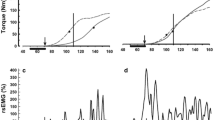Summary
The calves and thighs of ten patients with dystrophia myotonica and four normal controls were studied by CT. The morphology of the anterior and posterior muscle groups of the calf and the extensor, flexor and adductor groups of the thigh were studied and their attenuation values analysed. Clinical measurement of muscle force was compared with attenuation values in each muscle group. The principal morphological change observed in diseased muscle was fatty infiltration. The amount of fatty infiltration in the calf muscles paralleled the severity of clinically apparent disease. However, in the thigh, fatty infiltration was observed in the extensors of three of the five patients who clinically had involvement of calf muscles alone. Detailed analysis of attenuation values was no better in detecting diseased muscle except in the adductor group of the thigh in those patients with both proximal and distal lower limb involvement. Comparison between muscle force and attenuation values showed a significant correlation in only the anterior muscle group of the calf in the normal controls and in those patients with clinically apparent disease of the calf muscles alone.
Similar content being viewed by others
References
Buckle JA, Termote JL, Palmer Y, Corolla D (1979) Computed tomography of the human muscular system. Neuroradiology 17:127–136
Termote JL, Baert A, Corolla D, Palmers Y, Buckle JA (1980) Computed tomography of the normal and pathological muscular system. Radiology 137:436–444
Edwards RHT, Young A, Hosking GP, Jones DA (1977) Human skeletal muscle function: description of tests and normal values. Clin Sci 52:283–290
Scheffe H (1959) The analysis of variance. Wiley, New York
Welch BL (1949) Biometrika 36:293–296
Documenta Geigy (1975) In: Diem K, Lentner C (eds) Scientific tables. Geigy Pharmaceuticals, Macclesfield
Harper P (1979) Myotonic dystrophy, Vol 9: Major problems in neurology
Harrison TR (1974) Principals of internal medicine
O'Doherty DS, Schellinger D, Raptopouloi U (1977) Computed tomographic pattern of pseudohypertrophic muscular dystrophy: preliminary results. J Comput Assist Tomogr 1: 482–486
Buckle JA, Corolla D, Termote JL, Baert A, Palmers Y, Van der Bergh R (1981) Computed tomography of muscle. Muscle Nerve 4:67–72
Author information
Authors and Affiliations
Rights and permissions
About this article
Cite this article
Rickards, D., Isherwood, I., Hutchinson, R. et al. Computed tomography in dystrophia myotonica. Neuroradiology 24, 27–31 (1982). https://doi.org/10.1007/BF00344580
Received:
Issue Date:
DOI: https://doi.org/10.1007/BF00344580




